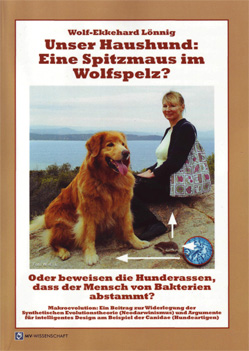 Evolution
Evolution
 Intelligent Design
Intelligent Design
The Dog Delusion

In his latest book, geneticist Wolf-Ekkehard Lönnig of the Max Planck Institutes in Germany takes on the widespread view that dog breeds prove macroevolution. His book is Unser Haushund: Eine Spitzmaus im Wolfspelz?, or in English translation, Our Domestic Dog: A Shrew in Wolf’s Clothing? (Monsenstein & Vannerdat, 2014). He shows in great detail that the incredible variety of dog breeds, going back in origin several thousand years ago but especially to the last few centuries, represents no increase in information but rather a decrease or loss of function on the genetic and anatomical levels.
After some introductory information about dogs, Lönnig goes to the heart of the matter: Dawkins’s dogma about dogs, which many other neo-Darwinians embrace as well. Richard Dawkins has argued that it isn’t difficult to imagine what random mutation and natural selection can really do, given all the differences that we see in dog breeds, produced in virtually a twinkle of the eye on an evolutionary timescale.
Dawkins, for example, concluded his New York Times review of Michael Behe’s book The Edge of Evolution with a shout out to canines:
From Newfies to Yorkies, from Weimaraners to water spaniels, from Dalmatians to dachshunds, as I incredulously close this book I seem to hear mocking barks and deep, baying howls of derision from 500 breeds of dogs — every one descended from a timber wolf within a time frame so short as to seem, by geological standards, instantaneous.
Lönnig considers the challenge from every angle. The discussion ranges across topics including the life span of dogs and wolves, genetic diseases, weight and size, neoteny, epigenetics, hypertrophy, hyperplasia, metabolism, plus specific types of dogs including “naked (hairless) dogs,” the Rhodesian Ridgeback, the Chinese Shar Pei, and more. Dr. Lönnig examines gene reaction chains or cascades, gene networks, and other gene interactions.
 He shows convincingly that it doesn’t take much to degenerate such systems through mutations (and duplications), which may be accomplished in a relatively short period of time. He provides demonstrations from his own experimental work. In just two years he induced an enormous amount of morphological variation by mutagenesis in a variety of plant species.
He shows convincingly that it doesn’t take much to degenerate such systems through mutations (and duplications), which may be accomplished in a relatively short period of time. He provides demonstrations from his own experimental work. In just two years he induced an enormous amount of morphological variation by mutagenesis in a variety of plant species.
The original design of the wolf shows an extraordinary degree of tolerance for functional decline. That is exactly what breeders depend on. The result is the many genetically and anatomically inferior breeds of our domestic dogs, fully dependent on human care and interest and typically unable to survive in the wild.
Lönnig continues with an in-depth discussion of the taxonomy of the Canidae (the family that includes the dogs), extant as well as extinct subfamilies. He focuses on the phylogeny of these creatures, considering especially the paleontological record, including the subfamilies Hesperocyoninae, Borophaginae, and Caninae. All three appear abruptly in the fossil record and almost simultaneously at that.
Yes, Lönnig touches on the theory of intelligent design, referring to books by Stephen C. Meyer (Darwin’s Doubt) and Casey Luskin (Discovering Intelligent Design).
Lönnig’s work is impressive, drawing on the research of more than a thousand scientists, reflected in more than eight hundred footnotes. The book has received endorsements including from Matti Leisola, professor emeritus at the Helsinki University of Technology, who calls the book a “colossal and detailed study.” Biologist Dr. Werner Gieffers, retired from the Max Planck Institute of Breeding Research, comments:
On the basis of research of many experts in the relevant fields, Lönnig proves that the enormous variability of our domestic dogs essentially originated by reductions and losses of functions of genes of the wolf.
And Michael Behe writes:
Dr. Lönnig shows forcefully that one of the chief examples Darwinists rely on to convince the public of macroevolution — the enormous variation in dogs — actually shows the opposite. Extremes in size and anatomy come at the cost of broken genes and poor health. Even several gene duplications were found to interfere strongly with normal growth and development as is also often the case in humans. So where is the evidence for Darwinian evolution now?
The science here is indeed solid. Intriguingly, Lönnig’s prediction from 2013 on starch digestion in wolves has already been confirmed in a study published this year.
The book is unique, considering a wide variety of canine characteristics (size, coat structure, coat and eye color, musculature, etc.). Admittedly, the sheer volume of documentation makes this work a bit more difficult to read than many dog fans might hope. Lönnig also presupposes some scientific background. On the other hand, after putting the book down, a fair-minded reader can’t help but agree that this spectacular case of degenerative microevolution has nothing to do with macroevolution, and casts no light on the origin of specified and irreducibly complex structures and functions.
Among its other virtues, Lönnig’s book appears at the right time. As Casey Luskin writes in the new book The Unofficial Guide to Cosmos, Neil deGrasse Tyson takes up the cry for dog breeds as a proof of macroevolution. In the first episode of Cosmos, Dr. Tyson concludes: “If artificial selection can work such profound changes in only 10 or 15 thousand years, what can natural selection do operating over billions of years?” The answer, he tells us, is “all the beauty and diversity of life.”
In truth, for all the undoubted charms of dogs, their breeding is nothing other than degeneration. But you won’t learn that, or a great many other things, from Cosmos.
If you don’t read German, by the way, don’t despair. For an overview of the subject in English, listen to Casey Luskin’s podcast interviews with Lönnig (here and here).
